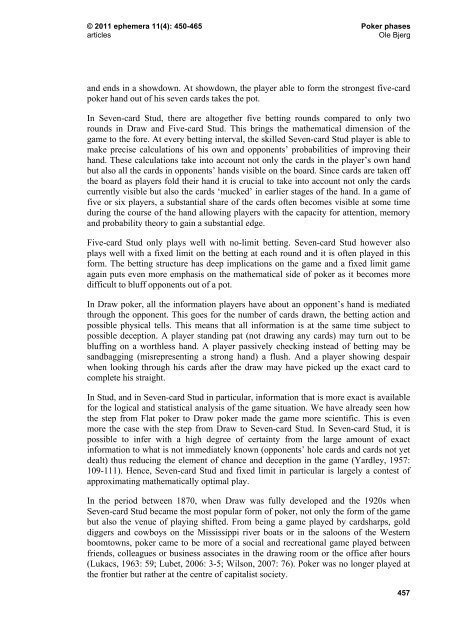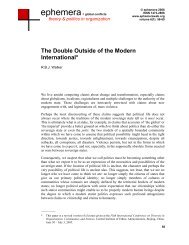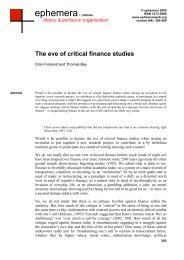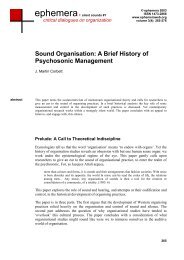Work, play and boredom - Ephemera
Work, play and boredom - Ephemera
Work, play and boredom - Ephemera
Create successful ePaper yourself
Turn your PDF publications into a flip-book with our unique Google optimized e-Paper software.
© 2011 ephemera 11(4): 450-465 Poker phases<br />
articles Ole Bjerg<br />
<strong>and</strong> ends in a showdown. At showdown, the <strong>play</strong>er able to form the strongest five-card<br />
poker h<strong>and</strong> out of his seven cards takes the pot.<br />
In Seven-card Stud, there are altogether five betting rounds compared to only two<br />
rounds in Draw <strong>and</strong> Five-card Stud. This brings the mathematical dimension of the<br />
game to the fore. At every betting interval, the skilled Seven-card Stud <strong>play</strong>er is able to<br />
make precise calculations of his own <strong>and</strong> opponents’ probabilities of improving their<br />
h<strong>and</strong>. These calculations take into account not only the cards in the <strong>play</strong>er’s own h<strong>and</strong><br />
but also all the cards in opponents’ h<strong>and</strong>s visible on the board. Since cards are taken off<br />
the board as <strong>play</strong>ers fold their h<strong>and</strong> it is crucial to take into account not only the cards<br />
currently visible but also the cards ‘mucked’ in earlier stages of the h<strong>and</strong>. In a game of<br />
five or six <strong>play</strong>ers, a substantial share of the cards often becomes visible at some time<br />
during the course of the h<strong>and</strong> allowing <strong>play</strong>ers with the capacity for attention, memory<br />
<strong>and</strong> probability theory to gain a substantial edge.<br />
Five-card Stud only <strong>play</strong>s well with no-limit betting. Seven-card Stud however also<br />
<strong>play</strong>s well with a fixed limit on the betting at each round <strong>and</strong> it is often <strong>play</strong>ed in this<br />
form. The betting structure has deep implications on the game <strong>and</strong> a fixed limit game<br />
again puts even more emphasis on the mathematical side of poker as it becomes more<br />
difficult to bluff opponents out of a pot.<br />
In Draw poker, all the information <strong>play</strong>ers have about an opponent’s h<strong>and</strong> is mediated<br />
through the opponent. This goes for the number of cards drawn, the betting action <strong>and</strong><br />
possible physical tells. This means that all information is at the same time subject to<br />
possible deception. A <strong>play</strong>er st<strong>and</strong>ing pat (not drawing any cards) may turn out to be<br />
bluffing on a worthless h<strong>and</strong>. A <strong>play</strong>er passively checking instead of betting may be<br />
s<strong>and</strong>bagging (misrepresenting a strong h<strong>and</strong>) a flush. And a <strong>play</strong>er showing despair<br />
when looking through his cards after the draw may have picked up the exact card to<br />
complete his straight.<br />
In Stud, <strong>and</strong> in Seven-card Stud in particular, information that is more exact is available<br />
for the logical <strong>and</strong> statistical analysis of the game situation. We have already seen how<br />
the step from Flat poker to Draw poker made the game more scientific. This is even<br />
more the case with the step from Draw to Seven-card Stud. In Seven-card Stud, it is<br />
possible to infer with a high degree of certainty from the large amount of exact<br />
information to what is not immediately known (opponents’ hole cards <strong>and</strong> cards not yet<br />
dealt) thus reducing the element of chance <strong>and</strong> deception in the game (Yardley, 1957:<br />
109-111). Hence, Seven-card Stud <strong>and</strong> fixed limit in particular is largely a contest of<br />
approximating mathematically optimal <strong>play</strong>.<br />
In the period between 1870, when Draw was fully developed <strong>and</strong> the 1920s when<br />
Seven-card Stud became the most popular form of poker, not only the form of the game<br />
but also the venue of <strong>play</strong>ing shifted. From being a game <strong>play</strong>ed by cardsharps, gold<br />
diggers <strong>and</strong> cowboys on the Mississippi river boats or in the saloons of the Western<br />
boomtowns, poker came to be more of a social <strong>and</strong> recreational game <strong>play</strong>ed between<br />
friends, colleagues or business associates in the drawing room or the office after hours<br />
(Lukacs, 1963: 59; Lubet, 2006: 3-5; Wilson, 2007: 76). Poker was no longer <strong>play</strong>ed at<br />
the frontier but rather at the centre of capitalist society.<br />
457








